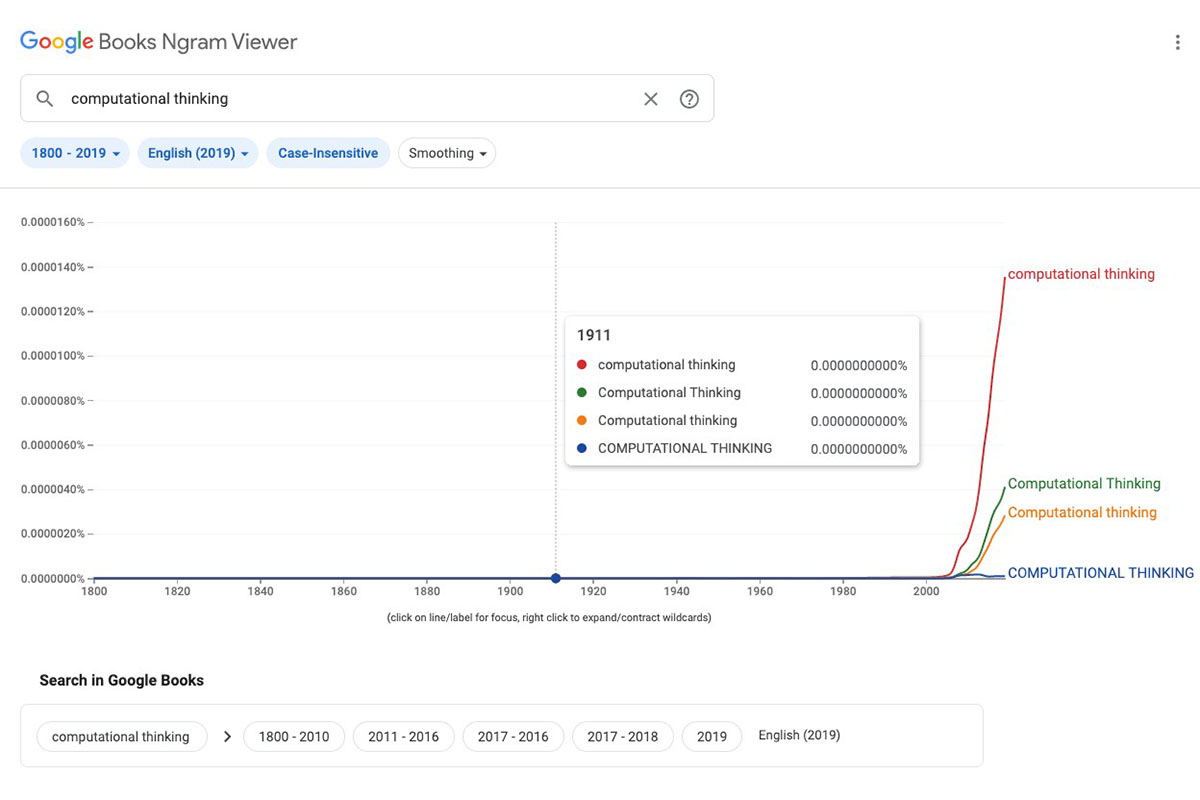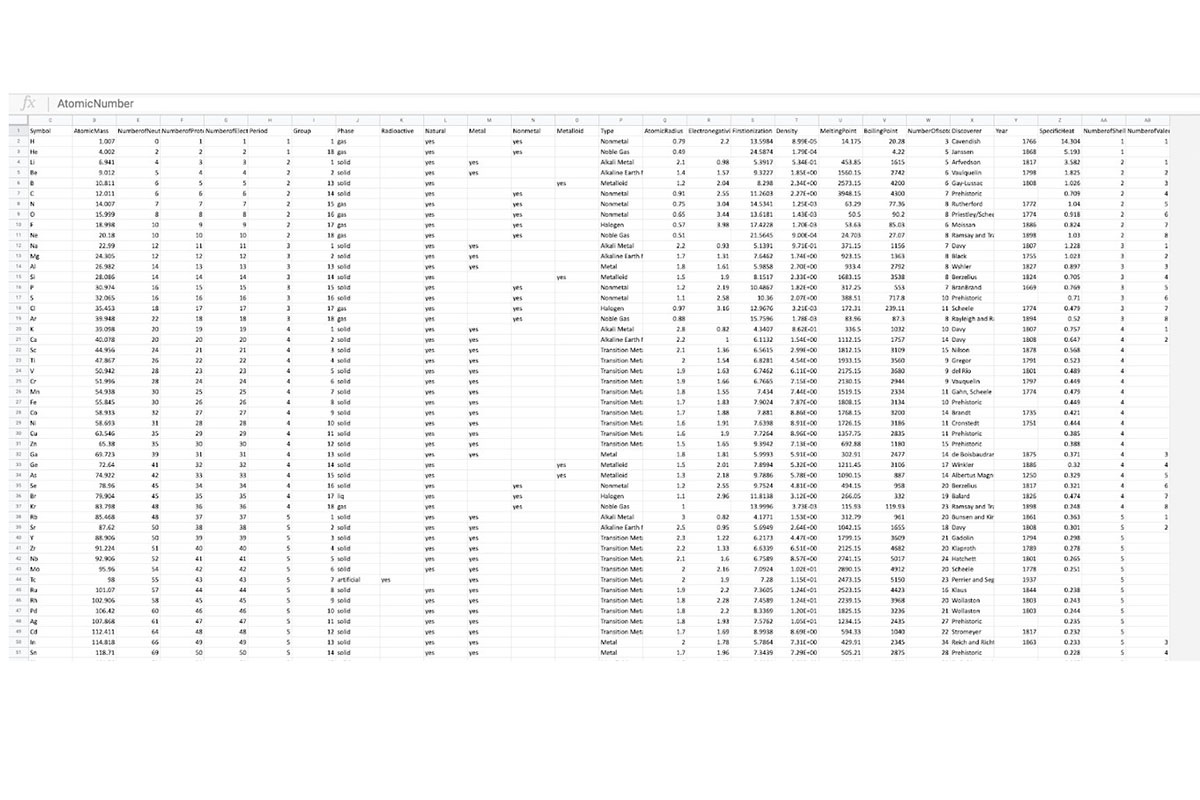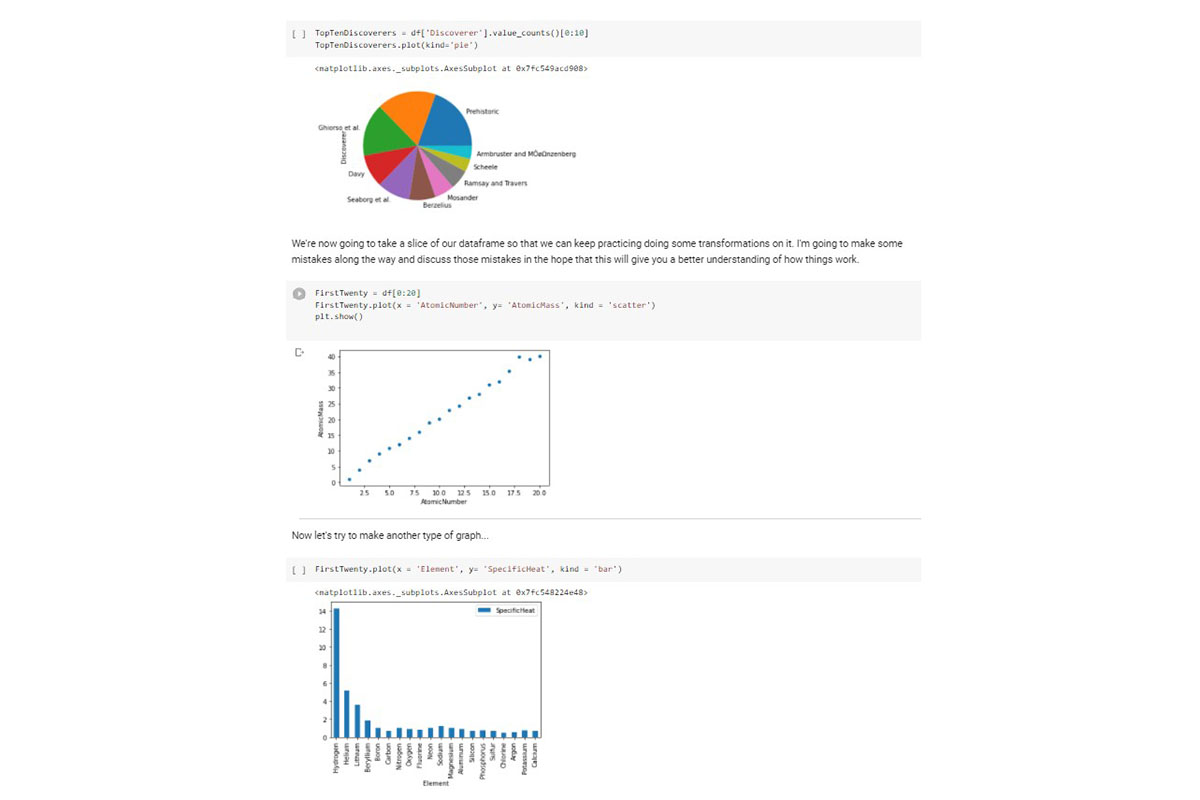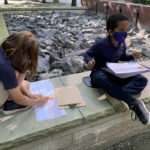Middle Years Programme (MYP) teacher Anthony Copeland explains what computational thinking is and how it helps people process problems using large datasets. He also shares why it’s a critical skill for students to learn and outlines how Fairgreen International School is integrating computational thinking skills in their science curriculum as they work to make Dubai a more sustainable city.
Computational thinking is a subject that has been growing in popularity since the early 2000s as our world has become increasingly dependent on computers. But don’t take my word for it, ask a computer and you will get the same results as those in the figure below.

Figure 1: Google results of computational thinking from 1800 to 2019.
Now take a moment to consider what has happened there: Somebody has designed a system which, using an algorithm, will take a word or phrase and search for its occurrence within Google’s entire corpus of digitised texts. This leveraging of computational power has allowed us to inquire in a way that would take a prohibitively long time, were we unable to offset the raw computation to electronic machines.
Computational thinking is the ability to frame and process problems in ways that can be assisted by the programmable power of computers and large datasets that are now available. In today’s computer-dependent world, this is a critical tool that students need to learn. You might be tempted to say that this thinking skill concerns only our technology teachers but in fact, there are lots of ways to integrate computational thinking into different subjects.
As computational thinking pioneer Steven Wolfram, who developed the web-based AI information tool Wolfram Alpha noted in his 2016 article ‘‘How to Teach Computational Thinking’’, there is hardly an academic subject left that doesn’t have an emerging field containing the word ‘‘computational’’.

Computational thinking at Fairgreen International School
Fairgreen International School is taking advantage of this opportunity by incorporating computational thinking skills in their new Middle Years Programme (MYP) science curriculum. We have begun by integrating activities that teach science with block based or typed programming. For example, in our MYP two space themed unit, students are challenged to consider the decision trees that might allow a Mars rover to solve problems. These will then be used to program Lego EV3 robots to navigate an unfamiliar environment.
Along with a focus on explicitly teaching computational thinking skills, we have also invested in sets of microcontrollers and sensors, predominantly Arduino Uno boards. These combined will enable students to use electronics and programming to build machines that collect and process real world data. Now they can begin to design their own machines for advanced authentic scientific inquiries.
“Whilst you don’t need technology to practice computational thinking, it can be a useful approach to incorporate it into your subject area”.
Innovation is one of our central pillars and demystifying the software and hardware that modern technology is made of enables our students to use it as a medium for creation. Whilst you don’t need technology to practice computational thinking, it can be a useful approach to incorporate it into your subject area.
Our teaching culminates in MYP five where we teach computational science as our first unit of inquiry. In this unit, students use the python programming language to transform large sets of data they have collected either online or through digital sensors. The statement of inquiry for this unit is that ‘Computing systems allow for complex patterns and functions to be identified for scientific and technical innovations’.
The common factual questions that students consider throughout this unit naturally tie into patterns and functions of nature. Questions like ‘Do the elements of the periodic table get larger as the atomic number increases?’ or ‘What is the relationship between the height of a ramp and the time it takes an object to roll down the ramp?’ are given as starting points and students are challenged to consider conceptual questions such as ‘How does Google Sheets or Python allow us to transform our data to answer these questions?’ and ‘What are the advantages of tracking the video of an object rolling down a ramp over timing it with a stopwatch?’. These questions lead us to debate whether computation has improved the natural sciences. This conversation is more multi-dimensional than it might seem at first, as students raised valid concerns that whilst computation and automation can save a lot of time, there is a growing knowledge and skill set that is being lost to the computers that perform the calculations for us.
MYP five computer science project examples
We start our unit by learning how to answer questions through data interrogation of medium sized datasets. One of the sets that we chose for this unit is related to the elements of the periodic table. We began by using the simple spreadsheet program ‘‘Google Sheets’’ to process the data in an easy and student friendly format. By MYP five, students are comfortable processing data tables with two columns but it’s a real change of perspective to consider how problems can be tackled using dozens of data columns.

The students explored the types of data transformations that could answer different practice questions such as ‘Do the elements of the periodic table get larger as the atomic number increases?’. Then, they had to decompose the question into essential data that would provide them with an answer and they had to create an abstraction of the dataset so that the file was more manageable for transformation and pattern recognition. Decomposition, abstraction and pattern recognition are all essential ideas in computational thinking and the language is used repeatedly and purposefully throughout the unit.
After these examples were explored, students were tasked with coming up with their own research questions and transforming the dataset to find insights. Whilst doing this, they were asked to record their process with screenshots that would eventually become a short presentation shared with the rest of the class. You can see an example of a presentation here.
“We are excited to see how we can connect our electronics units to our data science units”.
Once the students were comfortable with this approach, we started exploring how python programming language could be used to import the Google Sheet data into our program so that we could transform the data into graphs using the Pandas, MatPlotLib and Seaborn libraries. This is not an easy topic and the students needed a lot of support. Luckily, there are plenty of great resources available on websites such as Kaggle. Even better, there is now a Google app called Colaboratory (Or ‘Colab’ for short) which makes playing with python data processing a cinch. You can have a look at this article to learn more about the process of using Colab with Google Sheets and Google Classroom and I encourage you to add your own projects in addition to the examples already provided.

Next steps
At the time of writing this article, my students have just started exploring their own massive datasets with a combination of vernier probes and a fantastic mobile application app called PhyPhox, which allows students to use the existing sensors on their phone for data collection. A similar app that you might prefer to use is Google Science Journal, which has recently been acquired by Arduino. We are excited to see how well we will eventually be able to connect our electronics units to our data science units.
One example of this that we are developing with the Million Solar Stars program is ‘Project Sunflower’. In this project, students are challenged to design and build a sun-tracking solar panel that will also collect a wealth of local solar data.
Our next steps will be to collect these datasets and return to Google Colab to further explore Python’s utility for identifying patterns and functions within large and complex datasets. Our school exists inside Dubai’s ‘Sustainable City’, so sustainability is a central part of our school’s ethos and its local community. Our students are excited to use these new skills and techniques to contribute to efforts that are being made to make Dubai more sustainable.

Anthony Copeland recently joined Fairgreen International School in Dubai as the head of the science department after working at Renaissance College in Hong Kong as a learning technologies coach. He has worked with Harvard Project Zero and ISTE to explore methods for successful integration of frameworks and technologies such as maker education, project-based learning and artificial intelligence (AI). He built and manages Maker Learners, a space for educators to publish their own maker-centered learning projects, as he is interested in programming and electronics. Feel free to connect with him if you would like to share a project or simply find out more.
If you enjoyed this story, consider reading more below:



